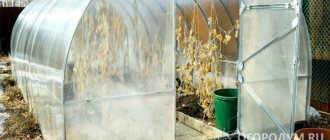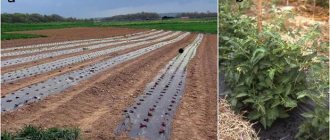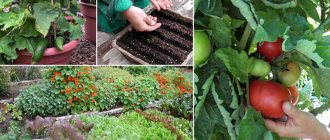You can often observe a picture where a properly cultivated, “watered and fed” crop produces a very poor harvest, and its quality wants to be better. It may not always occur to you that the “wrong” neighbors are to blame. Let's get acquainted and find out how to find good neighbors for the vegetables in your beds. We will talk about compatibility in the garden.
1. Compatibility of crops 2. General principles of compatibility Table of compatibility of vegetable crops 4. The benefits of mixed cultivation 5. What to plant next to what on the site 6. Table of protective plants
Photo: Favorable neighborhood for various crops in the garden
What is plant compatibility?
Plant compatibility is the harmony between crops planted next to each other, and it is achieved at the chemical level. The fact is that certain plants release various organic substances into the environment (air, soil): colins, phytoncides, etc. These substances can influence the growth and development of other plants, both negatively and positively. A broader and more scientific name for this phenomenon is allelopathy.
Each plant has its own strength of allelopathic activity. For example, corn and potatoes emit few volatile substances, so these crops do not poison the soil. At the same time, this makes them almost defenseless against weeds.
Let's look at the main groups of substances responsible for allelopathy:
Colin
Colins are released by plants and affect other plants, suppressing their vital functions. For example, such a colorless gas as ethylene (emitted, for example, by apple fruits) inhibits the germination of seeds, the growth and development of sprouts, and also leads to yellowing and premature falling of leaves, and even the death of neighboring plants.
This is only relevant when colins are released in high concentrations. Microdoses, on the contrary, stimulate the growth of neighboring plants. But too high a concentration of colins is dangerous even for the plants that secrete them.
It has been noticed that when located close to specimens that excessively produce colin, neighboring plants are affected: they turn out to be lethargic, stunted, with a thickened stem, short roots, and prematurely yellowed or fallen leaves. But with distance from the source of negative influence, the opposite effect is observed - growth stimulation.
In addition, the released substances accumulate in the soil and gradually create an allelopathic environment, which favorably affects some plants and inhibits others. That’s why it’s so important to observe crop rotation.
Phytoncides
Phytoncides have a detrimental effect on bacteria, protozoa and fungi. Thus, substances secreted by linden and birch trees suppress the development of harmful microorganisms and improve the growth of neighboring plants. Therefore, it is recommended to plant these types of trees along the borders of the garden plot. This will help protect the orchard from fungal diseases carried by the wind from diseased trees of neighbors in the dacha area.
As for garden plants, phytoncides of garlic, onion and horseradish kill many types of pathogenic microorganisms and fungi, and also repel insects. For example, the proximity of onions is beneficial for lettuce, because its phytoncides repel aphids.
Allelopathy
Fennel inhibits almost all plants.
Anise and dill slow down the growth of carrots.
In the garden, an apple tree and a raspberry tree planted next to each other will suffer. The apple tree also does not tolerate well the proximity to chestnut, birch, lilac, and viburnum.
It is not advisable to plant black currant bushes in close proximity to red and white bushes.
There are many similar examples among plants. And there is a scientific explanation for this: allelopathy.
Translated from Greek allelon - “mutually”, pathos - “influence”. In biology, this term refers to the ability of some organisms to secrete substances (phytoncides, colins, antibiotics) that inhibit or suppress the vital activity and development of others. Representatives of all kingdoms of living nature have such qualities: microorganisms, fungi, plants, animals.
Fennel is a tall (up to 2 m) perennial relative of dill; due to its “quarrelsome nature” it should be planted separately from all vegetable crops
Plants secrete suppressive substances from their leaves (for example, phytoncides of garlic, onions, marigolds) and roots. In trees, this occurs during guttation - the appearance of liquid droplets on the leaves, which is then washed away by rain and penetrates into the ground. Often the process is activated at the stage of bud bursting, as in poplar, linden, and chestnut. The root system can saturate the soil with organic compounds, vitamins, hormones, phenols, and enzymes.
The rules of compatibility and placement of crops in the garden are inextricably linked with the principles of crop rotation, which you can learn more about in the article on our website.
Why is it important to follow the rules of planting compatibility?
Some crops release beneficial substances for neighbors growing nearby, while others release harmful compounds and deplete the soil, preventing another crop that grows nearby from fully developing. Therefore, it is so important to follow the rules of planting compatibility.
The correct selection of companion plants allows you to:
- increase the amount of harvest;
Growing tomatoes and basil about 25cm apart can increase tomato yield by about 20%. And cumin, planted next to strawberries, helps to grow faster and more sweet berries.
- avoid soil fatigue;
- protect against diseases and increase the immunity of neighboring plants;
For example, horseradish increases potato disease resistance, and garlic is more effective than fungicides against potato late blight.
- prevent the growth of unwanted weeds;
- improve the taste and appearance of fruits;
Radishes grown with lettuce taste better. And peas and beans give spinach a natural color.
- increase the resistance of perennial plants to frost;
- control pests without the use of chemicals;
Personal experience has shown that peas planted next to potatoes reduce the number of Colorado potato beetles.
- Use the garden area economically.
However, even with the right surroundings, it will not be possible to grow a strong and healthy plant without following agricultural techniques. When planting, you should take everything into account:
- plant compatibility and crop rotation;
- need for moisture and sun (some plants are shade-tolerant, others are light-loving);
- the composition of the soil and the effect of applied fertilizers on it (some of them acidify the soil, others alkalize).
It is advisable to select crops with the same requirements for growing conditions. But when planting a crop that prefers acidic soil next to a crop that needs neutral soil, a borderline pH value should be created.
Defeat pests
Mixed plantings are also good because, including spicy plants in them, it is possible to create a barrier against pathogenic fungi, microorganisms, and insect pests.
Salvia officinalis and rosemary repel cabbage cutworms and carrot flies.
Chives cope well, like all onions, with carrot flies, but also drive away aphids and slugs
Essential oils of dill , coriander , anise , lemon balm , hyssop , , thyme , tarragon destroy many soil pathogenic bacteria and fungi.
Basil is not only a popular herb in many world cuisines, it helps fight tomato hawkmoth, asparagus squeaker, and whiteflies.
Basil repels pests, including mosquitoes and flies, and also improves the taste of tomatoes and peppers
Many spicy crops, in addition to their nutritional, medicinal and protective roles, are very attractive in appearance - for example, lavender.
Lavender will protect roses and other plants prone to aphids and help get rid of ants
You should definitely plant flowering “insecticides” such as marigolds , nasturtium , and calendula . By placing them even in separate groups throughout the site, you can create a bright, sunny effect of color spots that will bring great practical benefits.
Traditionally, marigolds are used to edge rows of cabbage because they repel the white butterfly. But their range of action is not limited to this. Marigolds save you from onion flies, drive away ants, strawberry weevils, wireworms and even mole crickets. Fragrant plants planted in the furrows of potatoes protect them from their worst enemy - the Colorado potato beetle. Matthiol, beans, and coriander also cope with this task. Various types of marigolds repel pests of melons and watermelons (see photo below), including melon aphids, bedbugs, and attract beneficial insects.
The stronger the floral aroma, the better the marigolds cope with the protection of melons.
Chicory planted next to garlic and onions will reduce the risk of nematode damage.
Nasturtium will protect the beds from aphids, whiteflies, and cabbageweeds. It also protects fruit trees, so in the fall it is recommended to dig it in the tree trunks. For representatives of the Solanaceae family (potatoes, tomatoes), nasturtium is considered one of the means of preventing late blight.
Many gardeners in the middle zone, the Urals, and Siberia grow nasturtium seedlings, along with vegetable crops, at home
A completely unpretentious annual plant, calendula (marigold), which has a number of medicinal properties used in folk and official medicine, will become an assistant in the biological control of many pests. Next to cabbage, onions, potatoes, in flower beds, it prevents the development of mosaics caused by viruses, many fungal infections (fusarium, “black leg”), drives nematodes out of the soil, prevents white butterflies from laying eggs on cabbage leaves, repels the onion fly, Colorado potato beetle.
mustard as a green manure that disinfects and heals the soil . Calendula, planted in August and plowed into the ground in the fall, will cope with this task perfectly.
Calendula grass can be safely placed in compost, and at the end of the gardening season, used as a green manure crop
Mixed plantings today are becoming more and more popular in gardening than “correct” monoculture beds. They create an external naturalness and natural beauty on the site, and the benefits in combating pests, diseases, weeds and increasing productivity are obvious.
Vegetable compatibility table
Below is a table of popular garden plants with exact compatibility between crops:
| Plant name | What crops are compatible with? | Incompatible plants |
| Watermelon | Potato | Horseradish, cabbage, tomatoes |
| Eggplant | Beans, tomatoes, lettuce, peppers, watermelon | Cucumbers, garlic, onions |
| Peas | Parsley, kohlrabi, spinach, lettuce, radish, radish, cucumbers, carrots, corn, watercress, eggplant, potatoes | Garlic, beans, celery, zucchini, onion, fennel, tomatoes |
| Melon | Radish, tomatoes, beans, corn | Cabbage, cucumbers, potatoes |
| White cabbage | Spinach, corn, beets, dill, celery, onions, potatoes | Grapes, sweet peppers, beans |
| Potato | Coriander, cauliflower, broccoli, kohlrabi, red cabbage, dill, horseradish, onion, garlic, spinach, watermelon, corn, radish, beans, beans and peas | Apple tree, raspberries, cucumbers, pumpkin, tomatoes, fennel, sorrel, sunflowers, cherries, beets |
| Corn | Beans, melons and watermelons, peas, zucchini, pumpkins, cucumbers, potatoes, cabbage, lettuce, beans | Onions, celery, fennel, beets |
| Bulb onions | Garlic, Brussels sprouts, broccoli, kohlrabi, beets, carrots, celery, spinach, strawberries, eggplant, cucumbers, tomatoes | Beans, beans, peas |
| Carrot | Onions, garlic, onions, lettuce, parsley, spinach, marjoram, tomatoes, peas, beans | Fennel, horseradish, celery, chard, parsley, dill, beets |
| Cucumber | Peas, beans, beans, lettuce, celery, dill, carrots, beets, radishes, cabbage, kohlrabi, onions, garlic, sunflowers, corn | Potatoes and tomatoes, radishes |
| Sweet pepper | Garlic, basil, onion, coriander, lettuce, eggplant | Hot pepper, cabbage, beans |
| Tomatoes | Garlic, radishes, carrots, onions, basil, spinach, parsley, cabbage | Fennel, dill, kohlrabi, peas, beets, potatoes |
| Parsley | Zucchini, basil, asparagus, watercress, dill, garlic, onion, peas and pumpkin, tomatoes | Sorrel and lettuce |
| Radish | Lettuce, watercress, spinach, dill, basil, carrots, beets, tomatoes, pumpkin, parsley, onions and garlic, beans | Chard, cucumbers, grapes |
| Leaf lettuce | Kohlrabi, cabbage, beets, rhubarb, cucumbers, radishes, peas, onions, corn | Beans, parsley, pumpkin and tomatoes |
| Beet | Onions, cabbage, lettuce, zucchini, lettuce, radishes and radishes, garlic, cucumbers | Fennel, potatoes, tomatoes, mustard, corn |
| Pumpkin | Corn, onion, lettuce, radish, beans | Potatoes and cabbage |
| Dill | Radishes, turnips, beets, cabbage, zucchini, garlic, cucumbers, beans, peas, fennel | Basil and carrots, tomatoes |
| Beans | Celery, melon, cabbage, radishes, strawberries and wild strawberries, carrots, beets, corn | Fennel, all types of onions, pumpkin, garlic, pepper |
| Garlic | Currants, cucumbers, beets, strawberries and wild strawberries, lettuce, parsley, carrots, tomatoes, onions | Beans, eggplants, potatoes, peas, cabbage, beans, grapes |
| Spinach | Cucumbers, strawberries, lettuce, cabbage, radishes, turnips, radishes, carrots | Fennel, tomatoes, beans and pumpkin |
| Sorrel | Melissa, strawberries, mint, asparagus, cabbage, radish, carrots and potatoes | Beans, peas, beans, basil, parsley and tomatoes |
Plant compatibility table in the garden
Examples of mixed beds
Most often, with mixed planting techniques, three vegetable crops are planted in the beds - early, main and subsequent. In this case, it is necessary to take into account the previous plant, as well as the compatibility of different crops.
In the spring, after warming up the soil and pre-processing it, early crops are planted in a continuous carpet - for example, lettuce (early), radishes. By the time they mature, they are thinned out and a subsequent plant is planted.
When mixed planting of vegetables is most effective, placing plants in a checkerboard pattern. After the radishes and lettuce, you can plant beans or spinach, which will ripen at the same time as the remaining radishes.
When the harvest of these vegetable crops is harvested, leaf and head lettuce and cucumbers can be planted in their place. Kohlrabi, broccoli or cabbage may be a good option. The optimal time for planting them is mid-July.
An example of mixed planting of vegetable crops:
- Prepare the soil after the snow melts and sow watercress or lettuce.
- After the greens have ripened and the harvest has been harvested, early varieties of potatoes can be planted in their place.
- Depending on the variety, potatoes ripen in early or mid-June. After this, you can plant grown seedlings of Chinese cabbage or kohlrabi in the beds. These vegetable crops are planted before the beginning of July.
Mixed plantings can be different. For example, after harvesting early potatoes, rosettes of strawberries or strawberries can be rooted in the beds.
Compatibility table for fruit trees and shrubs
Compatibility in the garden is also important. If trees and shrubs are planted in a chaotic manner, without respecting the proximity, then some plants may get sick and even die. For example, a walnut planted in a garden negatively affects all other plants. It inhibits their growth and has a bad effect on the taste of the fruit.
To avoid incompatibility, check out what you can and cannot plant seedlings with:
- Cherry. Grows well next to cherries, plums and grapes. Bad neighbors are pear trees, some apple trees and currants. Also, the tree does not grow well with garden representatives: strawberries, tomatoes and peppers. Nightshades can infect cherries with wilt.
- Pear. Other varieties of pears suit her well as neighbors. Comfortable with rowan. An apple tree is not suitable (although the proximity of a pear tree itself is favorable).
- Currant. Its two types, red and black, are not suitable for planting together next to each other. The latter loves well-moistened soil and shady areas. Red prefers drier soil and warm sunny areas. Currants and gooseberries get along well, but it is not recommended to plant them next to each other due to the same type of diseases.
- Blackberry. Grows well with raspberries (you can carry out the same treatment and fertilize the soil). Plants do not cross-pollinate each other. Blackberries and gooseberries go together. And currants and fruit trees are incompatible neighbors.
These were the most popular combinations in which gardeners often make mistakes. We have provided more examples in the table below.
| Fruit trees and shrubs | Favorable landing compatibility | Not suitable for the neighborhood |
| Apricot | Any varieties of apricot, cherry plum, pear, peach, plum, cherry, dogwood, blueberry, hazelnut | Apple and cherry |
| Quince | Apple, pear, hawthorn | Viburnum, bird cherry |
| Cherry plum | All varieties of cherry plum, mulberry, blueberry, apple, cherry plum, cherry, peach, sweet cherry, hazelnut, dogwood | Only pear |
| Hawthorn | Cherries and cherries | Apple tree |
| Grape | Pear, cherry and sweet cherry | Apple and pear tree creates shadow |
| Blueberry | Cranberries, currants, raspberries | Apple tree, sea buckthorn, apricots, pear |
| Pear | Cherry, sweet cherry, cherry plum, blueberry, hazelnut, dogwood, rowan | Peach, plum, apple, apricot |
| Honeysuckle | Gooseberry, plum, currant, grape, sweet cherry, quince, hawthorn, rose hip, juniper | Raspberry, apple tree, blueberry, pear, apricot, blackberry, bird cherry, rowan, walnut |
| Irga | Raspberries, black currants, gooseberries | Apple tree, walnut |
| Kalina | Lilac, rowan | Apple tree, chokeberry, chokeberry, spruce |
| Dogwood | Cherry, apple tree, sweet cherry, plum, peach, blueberry, hazelnut | Pear, sea buckthorn |
| Raspberries | Apple, pear, plum, blackberry, red elderberry, rowan | Strawberries, grapes, currants, sea buckthorn, elderberry |
| Sea buckthorn | All varieties of sea buckthorn of the opposite sex (for pollination) | Currants, raspberries and more, since sea buckthorn greatly oppresses all trees and shrubs |
| Peach | Does not like proximity to other cultures | Cherry, cherry, apricot, pear, apple, walnut |
| Rowan | Viburnum, pear | Apple tree, cherry |
| Plum | Sweet cherry, sour cherry, black currant | Pear and apple tree, apricot, walnut trees |
| Red currants | Apple, peach, cherry, rosehip | Black currant, honeysuckle, raspberry, walnut |
| Black currant | Golden currant, plum | Hazel |
| White currant | Cherry, red currant | Raspberries, black currants |
| Golden currant | Black currant, plum, honeysuckle | Hazel |
| Mulberry (mulberry) | Only other mulberry varieties are favorable | Oppresses all trees and shrubs |
| Hazelnut | Raspberry, old apple tree, hazelnut | Affects almost all trees and shrubs |
| Cherries | All varieties of cherries, cherry, blueberry, dogwood, sea buckthorn | Plum, pear, cherry plum, apple, peach and apricot |
| Apple tree | Raspberries, grapes, other apple varieties, plums, honeysuckle | Cherry, peach, cherry plum, elderberry, rowan, walnut |
Features of growing cabbage
Cabbage is one of the most cold-resistant vegetable crops. Due to its unpretentiousness and frost resistance, it is successfully cultivated even in areas with short and cool summers. The main thing is to create comfortable conditions for her:
- Temperature. The culture can tolerate temperatures as low as -5°C. Optimal indicators are +15-18°C. The plant does not like heat and grows well in cool weather.
- Humidity. Cabbage prefers moisture. The size and taste of the heads of cabbage depend on watering. Excess moisture should not be allowed, as this can provoke various diseases.
- Illumination. The culture does not grow well in shaded areas; it needs sunlight, so it can form large and dense heads of cabbage.
When growing cabbage, you need to take into account both neighbors and predecessors.
Cabbage is not the most compact plant. Its spreading and massive leaves can create shade for many low-growing crops, which can prevent the heads of cabbage from fully developing.
When choosing neighbors for her, you should consider some features:
- Cabbage needs space. When growing other crops next to it, it is important to maintain a distance between them of more than 30 cm.
- Plants growing nearby should not block access to light.
- It is better to place crops on the site that require the same amount of moisture and fertilizing with the same nutrients. This will greatly simplify growing and save time.
- It is also important not to violate the rules of crop rotation. The heads of cabbage will feel bad in the same place as last season, due to the presence of toxins in the soil that they leave behind.
The best predecessors are potatoes, cucumbers, greens, pumpkin, zucchini and representatives of legumes.
Cabbage does not need special conditions or careful care. Its main enemies are annoying insects. Not all summer residents have the opportunity to constantly process plantings and remove beetles and caterpillars. Choosing the right neighbors will help in pest control.
Crops with an early ripening period get along well in the garden. After harvesting, the heads of cabbage will have a lot of free space for development. It is also recommended to plant plants that are not afraid of cold weather, leaving the necessary space for planting cabbage seedlings.
How to properly organize joint plantings?
Joint planting is when a garden bed is taken and many different crops are planted on it, which complement each other. To do this, they first draw up a plan indicating the selected companion plants.
When planning such a multi-planting, you can not only successfully arrange the plants, but also create a beautiful composition.
What recommendations should be followed when assembling a joint bed:
- Make the width of the bed generous. It must be at least one meter. Length – 3-4 m.
- Take crop rotation into account. Plant plants that previously (last season) did not grow on a specific piece of land.
- Alternate plants with different root systems in the garden bed (underdeveloped root - large root).
- Place earlier ripening crops along the edges of the bed (most often these include greens, herbs, strawberries).
- Pay attention to plant care requirements. All specimens planted nearby should be equally moistened, have similar lighting requirements and be suitable for the specific acidic environment of the soil.
Pros and cons of co-location
Combining crops in one greenhouse has a number of undoubted advantages . Among them:
- saving scarce space;
- the opportunity to reduce heating and lighting costs , which increase when operating several greenhouses;
- closed ground is suitable for particularly capricious and demanding crops;
- The drip irrigation system and vents make it possible to individually regulate the temperature and humidity level.
Mixed plantings in a greenhouse have some disadvantages :
- possibility of cross-pollination;
- plants can be affected by pests typical of other crops;
- in small greenhouses it is difficult to create conditions that are optimal for each type of vegetable;
- there is a danger of thickening of plantings.
Examples of successful joint plantings
To correctly create mixed plantings, familiarize yourself with the compatibility of certain crops and pay attention to illustrative examples and sowing patterns.
There are 4 ways to plant plants together:
- Simple. Several crops that are similar in agricultural technology are being planted. Equal in terms of ripening and care.
- Alternate. Plants are not planted together; the order of timing is simply taken into account. Two different crops are grown in one place at different times.
- Leading. Even before the first crop is harvested, a new crop is planted in place, gradually replacing the first.
- Intensive. Together they grow crops that have a positive effect on each other: protect against pests, improve taste and volume, and strengthen the immune system.
What options are successfully used by gardeners:
- Eggplants next to peppers. Good neighbors in the garden. The crops have similar agricultural techniques. But it’s better to plant sweet peppers, otherwise they can impart bitterness to the eggplants.
- Pepper next to cucumbers . Favorable combination. Cucumbers are planted in the center of the bed, and peppers along the edges. Most often in a greenhouse.
- Watermelon and melon. Acceptable proximity. Similar agricultural technology. But, due to growth, it is advisable to plant them further away.
- Carrots next to garlic. Such a successful planting will protect carrots from pests and garlic from scab.
- Carrots next to onions. You can plant them side by side and even together. Protect each other from pests.
- Onions next to strawberries. It is permissible to plant together, since the meadow protects the berries from rotting.
- Dill and cucumber. Both cultures feel comfortable.
- Radish and garlic. Protects the “first one” from the cruciferous flea beetle and slightly shades the radishes so that they do not start growing ahead of time.
What crops should not be combined in one garden bed:
- Onion next to garlic. Similar plants can compete with each other. More often than not, garlic is dominant.
- Tomatoes and cucumbers nearby. They are characterized by different agrotechnical conditions. Cucumbers love frequent watering and a lot of sun, they do not tolerate drafts, and tomatoes love fresh air and lack of sun.
- Tomatoes and peppers nearby. The crops are considered nightshades and can easily infect each other if one of them gets sick.
- Zucchini next to pumpkin. They will oppress each other. As a result, both crops will not receive the required amount of nutrients. It is recommended to plant at a distance of at least 4 meters from each other.
Mixed planting schemes:
Principles of crop rotation
The principles of crop rotation include only one basic condition. The same fruit and vegetable crops should not be grown in the same place for the second year in a row. The complex crop rotation system is designed for 10 years. With simpler systems, calculations are possible for shorter periods, for example, 3-5 years. In any of them, fruit and vegetable crops alternate.
Any gardener, having understood the principles of crop rotation, can easily draw up a planting plan for his plot.
The most common principles of crop rotation are: alternation of groups of crops, families (root crops, greens, vegetables, leaf crops) with a minimum rotation of 3-4 years.
Most plants from the same family get along well close to each other. But there are exceptions, for example, nightshades, carrots, fennel, cucumbers, and parsnips cannot be placed close to related crops. Related plants, when infected with pathogenic bacteria or harmful insects, quickly spread the disease to neighboring plantings. A hot pepper, when adjacent to a sweet one, cross-pollinates it, and the fruits of the second one become bitter. When planting cucumbers and zucchini in neighboring beds, the taste of the cucumbers deteriorates.
There are many examples and it is better to distribute crops according to their compatibility before planting. Thus, crop rotation takes into account previous and neighboring crops on the site.
Crop rotation is a prerequisite for good harvests: video
Is it possible to plant different varieties next to each other?
Most often, it is allowed to plant different varieties of the same crop next to each other. Let's look at a few plants:
- Strawberry. Despite the myth about the prohibition of growing different varieties of this berry in one place, different varieties are allowed in the same bed. There will be no crossings or pollinations between each other.
- Grape. Different varieties on one plantation are very welcome. They cross-pollinate among themselves, improving productivity. Does not affect the taste of the variety. It is only important to plant varieties with the same height, so that one variety does not shade another.
- Raspberries. It can also grow mixed up. The berry will not hatch and will not lose varietal characteristics.
How else do plants influence each other?
- Tall plants can be planted together with shorter ones - they will create the necessary shade and protect from the wind.
- All legumes are capable of accumulating nitrogen in their nodules, which they absorb from the air. Not only do they not take nitrogen from the soil, but they also share their own accumulations with their neighbors, releasing it from the nodules in a form that is easily digestible by other plants.
- Substances released from the roots and leaves of some plants can repel pests from others, or throw them off the scent with their strong odor.
Alevtinka Member of FORUMHOUSE
The main thing is to confuse the pest, because it follows the smell.
4. The onion fly will be scared away from the onion by the smell of carrots, and the spider mite will think three times before attacking the carrots; onions are planted next to the bark. Cruciferous flea beetles cannot tolerate the smell of garlic, etc.
5. The most delicious, large, non-bitter, pure radish grows in the same bed with bush beans. In such plantings, beans are sown two weeks later than radishes.
What plants should not be planted nearby?
There are some pairs of plants that are not recommended to be planted not only together, but also next to the beds. These include:
- Peas and onions. The second inhibits the development of peas.
- Potatoes and tomatoes. Both are nightshades. They have the same diseases and are susceptible to pests.
- Carrots and dill. There are more rumors than facts, but gardeners claim that grass prevents carrots from growing.
- Cabbage and grapes. The taste of the berries spoils.
Unwanted neighbors
In addition to good neighbors, there are many undesirable crops that are not recommended to be planted nearby. The poor compatibility of cabbage with other plants is expressed in their popularity among various harmful insects, or they take away useful substances from it, acting as competitors in the struggle for resources.
Tomatoes
Planting cabbage next to tomatoes is a bad idea. Tomato crops tend to accumulate rot, which is very attractive to slugs. And the abundant watering required by the heads of cabbage can have a detrimental effect on the tomatoes and leave the summer resident without a harvest. Therefore, this plant should be placed at the greatest possible distance from the cabbage.
Cauliflower
Cauliflower and white cabbage do not get along well together; the yield of both types decreases. Everyone needs their own garden bed, preferably at a distance of at least 1 m.
Eggplant
It has no effect on cabbage, but the growth rate of eggplant may be reduced. Heads of cabbage need a much larger amount of moisture, and the “little blue” ones need a dry climate.
Carrot
The carrot root cannot develop normally when adjacent to cabbage. Root crops begin to rot and do not receive the required amount of nutrients. Crops are affected by identical diseases, and they are also attacked by the same harmful insects.
It is better to plant carrots in compliance with the rules of crop rotation - the next year after cabbage. The soil is already enriched with a sufficient amount of nutrients, which allows you to apply less fertilizer.
Pumpkin
Pumpkin depletes the soil, taking from the soil all the valuable minerals that the heads of cabbage need, and has a strong and powerful rhizome. Therefore, cabbage does not do well near herbaceous plants of the Pumpkin family.
The best solution is to plant melons away from the cabbage bed.
Fennel
Placing cabbage in close proximity to fennel is prohibited. The substances released from this vegetable crop inhibit the root system of cabbage, so these plants will not be able to fully grow and develop. This will affect the level of productivity and fruit size.
Celery
If you place celery near the cabbage, you can attract the attention of the cabbage butterfly. But this grass also repels midges.
Grape
Grapes are an unfortunate neighbor because they take away the cabbage’s light. These plants also compete for nutrients. When next to grapes, cabbage also experiences a lack of nutrients, which leads to its depressed state, sores and slow death.
Nasturtium
Although the flowers belong to the phytoncides - they repel moths and whites, but at the same time they attract the attention of aphids, which are the most dangerous enemy of cabbage. These small insects can destroy the entire crop.
Green manure
You cannot plant mustard, oilseed radish, rapeseed, or rapeseed near cabbage. These plants have poor compatibility, and instead of doing any good, they will harm the cabbage ovaries.
Garden neighbors that can repel insects
There are plants that effectively fight pests, improving the quality of the crop.
List of pests in the garden and their “repellent”:
- Carrot fly. Onions, sage, garlic and radishes are suitable for destruction.
- Slugs with snails. Wormwood, parsley, mint and sage will help.
- Aphid. It will be brought out by coriander, mint, marigold flowers, mustard, nasturtium and onion.
- Colorado beetle. It helps with sage, thyme, tansy, coriander, capuchin, flax, beans and myta with thyme.
- Nematode. Prevention with chicory, marigolds and marigolds.
- Cabbage caterpillars. Mint, basil, wormwood, nasturtium and tansy.
Do all plants love proximity to green manure?
Green manures are helper plants that help improve soil quality. They are grown so that in the next cycle, subsequent plantings of crops will be strong and tasty. They protect the soil from weeds and control some diseases and pests.
Green manure can be planted next to plants, but there are nuances in which they are considered bad neighbors. These include:
- Potato. It is not planted next to rye, as green manure attracts wireworms, which are destructive to potatoes.
- Strawberries and tomatoes. Rapeseed is not suitable for their neighborhood, as it breeds nematodes.
- Radishes and cabbage. They do not grow well with mustard. It attracts the cruciferous flea beetle.
Plant compatibility is a delicate process that requires careful study of the topic in order to competently plan your area for planting. This significantly saves space and the environment in terms of reducing (or even eliminating) chemical processing of crops due to their “mutual offset” with each other.
Mixed planting of vegetables: main advantages
Joint planting of garden crops is great for small garden plots. They have a positive effect on the health of the soil and its fertile composition, and do not impoverish it due to compliance with the rules of crop rotation.
Mixed plantings have several advantages:
- Plants in combined beds are divided into main and auxiliary. The latter create favorable conditions for the development of the main crop, protect it from weeds and retain moisture in the soil.
- Combined plantings help improve the taste and nutritional properties of vegetable crops.
- This method allows you to reduce the cost of mineral fertilizers and reduce the use of organic fertilizers.
- Proper planting allows you to harvest juicy vegetables throughout the season, right up to autumn.
- The mixed type of planting allows you to get a large harvest from a limited area compared to growing a monoculture.
With properly organized mixed plantings of vegetables, the risk of plant diseases and the appearance of insect pests is reduced.
You can plant flowers near vegetable crops; it is advisable that the flowering period of these plants coincide. In this way, the flowers will attract pollinating insects.











